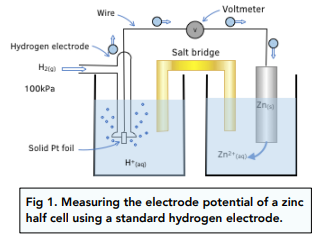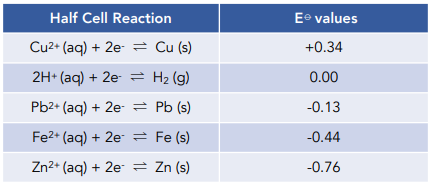Electrode Potentials and Electrochemical Cells - Electrode Potentials (A-Level Chemistry)
Electrode Potentials
Electrode Potentials
As we learnt in previous tutorials, when we dip a metal into a solution of its ions to form a half-cell or electrode, a dynamic equilibrium gets established, where the rate of electron loss equals the rate of electron gain.
At equilibrium, the electrons on the metal strip set up a potential between the metal and the ions in solution. We call this value an electrode potential and it is measured in volts.
This potential is an indication of how easily the metal loses electrons. The greater the tendancy for the metal to lose electrons, the greater the potential.
Measuring Electrode Potentials
The Standard Hydrogen Electrode
We cannot measure the potential of a single half cell, we can only measure the potential difference between two different half cells.
To compare the ability of different metals to lose electrons, a standard electrode is needed that can be connected to other half cells.
One of the half-cells that can be used as reference is the standard hydrogen electrode.
This half cell consists of:
- Hydrogen gas – Pure hydrogen gas is added at a pressure of 100 kPa and a temperature of 298 K.
- Electrolyte – The electrolyte in the half cell is a solution containing 1 mol dm-³ of H+ ions.
- Electrode – Hydrogen is a gas, therefore an inert solid electrode is required. Platinum is chosen for this purpose.

Standard Electrode Potentials
The standard hydrogen electrode is given an electrode potential of E⦵ = 0.00 V. The electrode potentials of all half cells are measured against this standard. They are always written as reduction reactions.
Electrolyte concentration, pressure and temperature all affect electrode potential values. In order to make them comparable they have to be measured under standard conditions of:
- Concentration – All ion solution should have a concentration of 1.00 mol dm-³
- Temperature – Room temperature, which is 298K (25ºC)
- Pressure – Any gases should be at a pressure of 101 kPa (1 atmosphere)
The voltage measured when a half cell is connected to a standard hydrogen electrode under these standard conditions is referred to as standard electrode potential. The symbol for this is E⦵ (E standard).
The more positive the value of the standard electrode potential, the greater the tendancy for reduction; these are the strongest oxidizing agents.
The more negative the value of the standard electrode potential, the greater the ability of the elements to be oxidized. These are the strongest reducing agents.
Here are some examples of standard electrode potentials:

Factors affecting Electrode Potentials
Changes in temperature, pressure or concentration will effectively change the position of the redox equilibrium and hence the electrode potential of the half-cell.
If the position of equilibrium is shifted in favour of the forwards reaction (the reduction), the electrode potential becomes more positive.
If instead the position of equilibrium is shifted in favour of the backwards reaction (the oxidation), the electrode potential becomes more negative.
The electrode potential for a half cell under non-standard conditions can be predicted using the Nernst equation:

Where:
E = electrode potential under non-standard conditions
E⦵ = standard electrode potential
R = gas constant (8.314 JK-¹mol-¹)
T = Temperature in Kelvin
Z = number of electrons transferred
F = Faraday Constant in C mol-¹
Ln = Natural logaritm
[oxidised] = concentration in mol dm-³ of the oxidised form in the half equation.
Using Standard Electrode Potentials
When two half cells are made into an electrochemical cells, we can use the standard electrode potentials to decide how to set the cell up.
The cell which is most likely to be oxidised, with the most negative standard electrode potential, is placed on the left hand side of an electrochemical cell.
Worked example
Use the table of standard electrode potentials above to decide how to set up a cell containing Pb/Pb²+ ions or Zn/Zn²+ ions. Write the full ionic equation for the reaction.
Answer:
Pb²+ + 2e- ⇌ Pb E⦵ = -0.13 V
Zn²+ + 2e- ⇌ Zn E⦵ = -0.76 V
1. Determine which cell has the most positive electrode potential. The reaction with the most positive potential will process in the forward direction. The reaction with the least positive potential will proceed in the reverse direction.
2. Write the actual reactions which occur. For this example, the reactions taking place are:
Pb²+ + 2e- → Pb
Zn → Zn²+ + 2e-
3. Determine which reaction is oxidation (left) and which is reduction (right). The Zn/Zn²+ half cell undergoes oxidation and is placed on the left hand side. Pb/Pb²+ half cell undergoes reduction and is placed on the right hand side.
4. Determine the overall ionic equation. Balance the equations so that the electrons cancel out. Then add the two half equations together.
Pb²+ + Zn → Pb + Zn²+
Worked example: Use table of standard electrode potentials above to decide which is the weakest reducing agent.
Answer:
Zn²++ 2e- ⇌ Zn = E⦵ = -0.76 V
This reaction has the most negative electrode potential .
The reverse reaction is most likely to occur so Zn is the strongest reducing agent and the weakest oxidising agent.
Cu²++ 2e- ⇌ Cu = E⦵ = +0.34 V
This reaction has the most positive electrode potential.
The forward reduction reaction is most likely. Cu²+ will be the strongest oxidising agent. Therefore the reverse reaction is least likely to occur and Cu is least likely to be oxidised. Therefore Cu is the weakest reducing agent.
An electrode potential, also known as a reduction potential, is a measure of the tendency of a metal to be oxidized or reduced at an electrode.
Electrode potentials are significant in electrochemical cells because they determine the direction of electron flow and the efficiency of the overall cell reaction.
The standard hydrogen electrode (SHE) is a reference electrode used to determine the electrode potential of other electrodes in an electrochemical cell.
A half-cell reaction is a reaction that occurs at one of the electrodes in an electrochemical cell, where electrons are either gained or lost.
The relationship between electrode potential and cell potential is that the cell potential is the difference between the electrode potentials of the two electrodes in an electrochemical cell.
A galvanic cell, also known as a voltaic cell, is an electrochemical cell that produces an electrical potential by means of a spontaneous redox reaction.
A non-spontaneous reaction in an electrochemical cell is a reaction that requires the input of energy to occur.
The relationship between electrode potential and Gibbs free energy is that a reaction is spontaneous if its Gibbs free energy change is negative, and its electrode potential is positive.
The electrode potential of an electrode is determined by measuring the potential difference between the electrode and a reference electrode, such as the standard hydrogen electrode (SHE).
The applications of electrode potentials in industry and technology include their use in batteries, fuel cells, and electroplating. They also play a role in the production of aluminum, the extraction of metals from ores, and the purification of water.






Still got a question? Leave a comment
Leave a comment